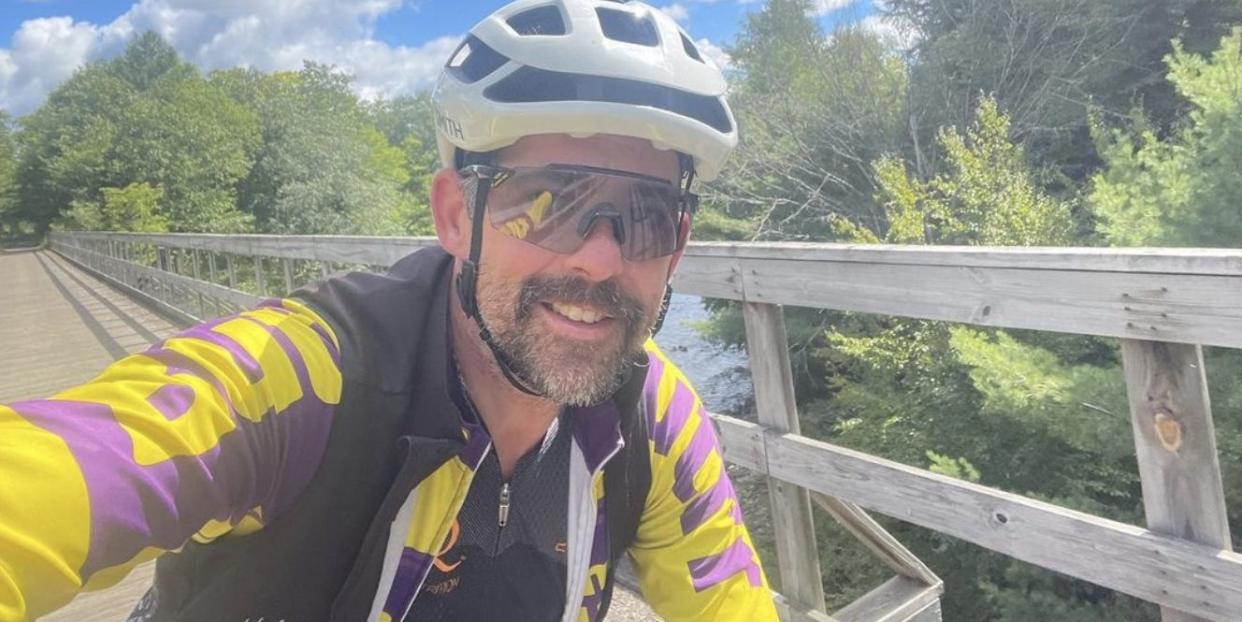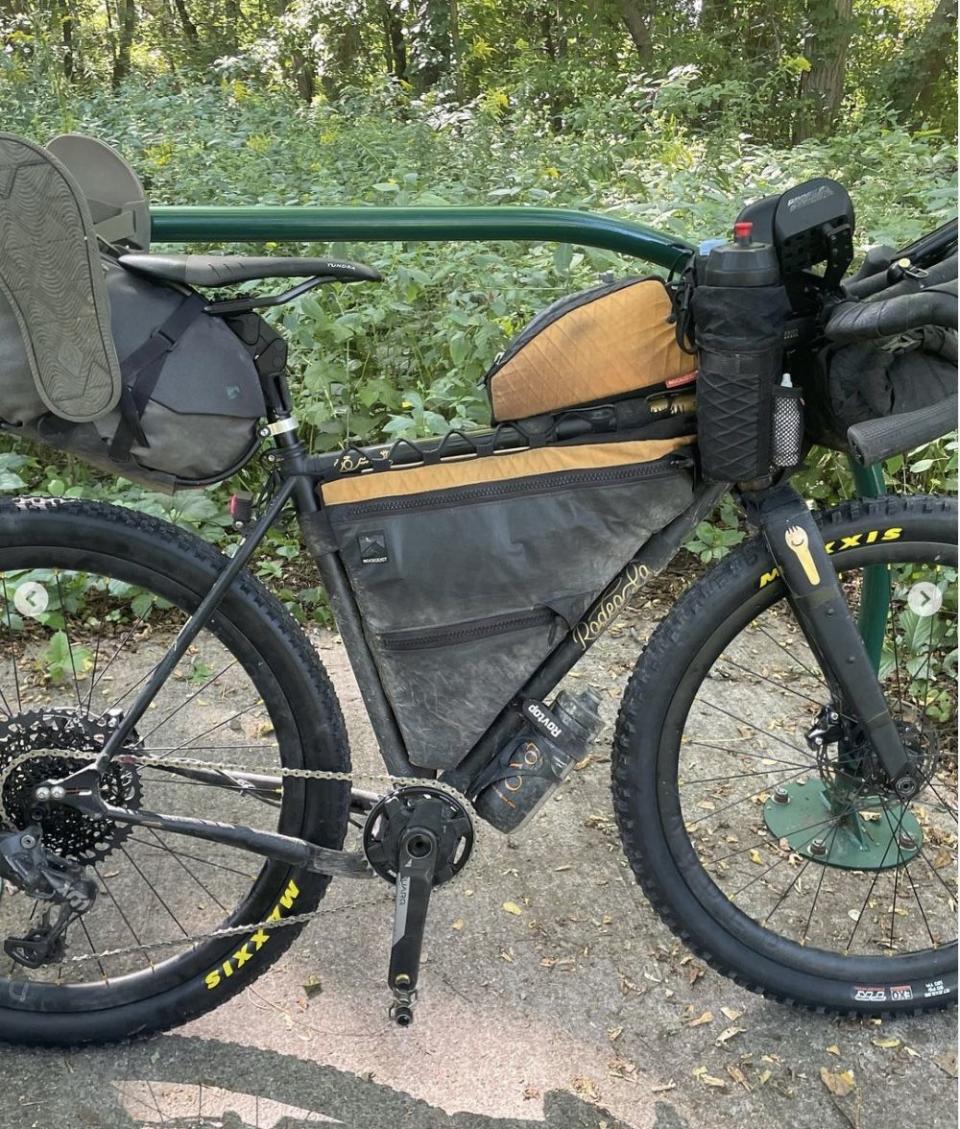This Bikepacker Is Traveling 5,900 Miles on a Route That’s Never Been Done Before

Biking is the easy part. Catching a ferry on time? Now that’s where Eddie O’Dea first got stuck. On August 1, the Georgia-based cyclist started his trip from Cape Spear to Key West, following the new Eastern Divide Trail for nearly 6,000 miles—many of them on ATV and double track paths. The journey began in Cape Spear, Newfoundland, and in the first week, almost stalled out as O’Dea tried to catch the ferry in Port aux Basques only to find it overbooked. But that didn’t stop him—in fact, it gave him a bit of extra time to get over a tiny bout of food poisoning. Back on the road, we caught up after he made it into Maine and began to ride into more familiar territory.
According to Bikepacking.com, the new Eastern Divide Trail (EDT) is the “longest contiguous off-road-centric bikepacking route in the world” at over 5900 miles. (Specific? Yes. Rad? Also yes.) The ‘longest in the world’ plus ‘brand new’ labels make it nearly impossible for someone like O’Dea to not make an attempt at it.
“It's brand new, and I want to put a little light on it and see if it could be done all the way through. That's yet to be seen,” he laughs. “Even a year and a half ago, yeah, things were still pretty raw and big chunks of it weren’t mapped yet. Unfortunately, that's still partially the case at the moment. We can blame some of that on COVID, just not being able to get into Canada to do the scouting, which I’d hoped to do ahead of this trip. So it was a bit free-form through there.”
The planning process for an adventure like this that will likely take easily two months or more began over a year ago, as the route started to take form. “It really came about with a conversation with my girlfriend, Audrey. She was going to do Tour Divide. I didn’t want to do that again, but that made me realize I wanted to do something. And so this popped in my head.”
As an experienced bikepacker, the riding aspect wasn’t daunting, but ‘going first’ on a route like this means figuring out where to send certain ride food and other key parts that require replacing or refilling and might not be easy to find in a standard bike shop. It means that bike shops along the route won’t be expecting a haggard bikepacker and his bike. And it means some trails may appear to go in the right direction, but trail off into dead ends and detours.
“With the Tour Divide or these other popular routes, you can read people's stories, see what hardships they had, see all the different pitfalls,” he says. “None of that exists for this route. It’s a whole different challenge. And that intrigued me.”
For instance, he wasn’t totally expecting 500 miles of the 560 that cover Newfoundland to be ATV track that was soft gravel and rough terrain. “There are different levels of ATV track,” he says. “You never know what you’re going to get, but this was a lot of really soft surface and long, slow climbs where there's no reward on the other side, because it's so gradual and soft coming down that you have to pedal anyway.”
"I underestimated how long it would take me by about a day and I missed the ferry that I booked in Port aux Basques,” he explains. “I got stuck there for three days waiting for a spot on the next ferry since they only run twice a day and they’ve been super booked up. And once I made it over to Nova Scotia, I started riding and I had a couple of good big days… but my gut was still off, and a couple days into Nova Scotia, I had to detour to the hospital for some IV fluids. Eventually, they let me go on with some antibiotics, and I felt OK after that.” (The other issue in Canada? A lack of streaming ability, so it was some quiet riding.)
What does one ride for something like this? “I’d call it an adventure gravel bike,” O’Dea says. “I've got some decent 27.5” MTB tires on here, a 2.3 in front and 2.2 in the rear. It’s nice to have a bit of cushion with those. That said, it's certainly not a mountain bike and I could use a bit more suspension, but it's it's doing a job. In my packs on it, I have a little single pole tent, a sleeping pad, and silk sleeping bag plus a puffy jacket. It’s been a little chilly at night in Canada but it should be less of an issue when I get further south.” He’s also using a Dyno hub to charge his Garmin computer, phone, inReach Spot Tracker and lights along the way. All in all, he’s toting between 55 and 60 pounds of gear, depending on how full his hydration pack is at any given time.

He also sent 15 boxes of supplies ahead to various post offices along the route, so that he could restock things like CBD Stat, Torq bars, and chamois cream—in particular, the new Ultra Balm blend from Chamois Butt’r, formulated for long rides like this. To prep for the ride, he started with his heavy bike with just the packs, and slowly ramped up his ride volume and weight of the bike until he was used to a 55-pound bike. “I even was doing group rides with it,” he admits. He also did strength training and yard work wearing a weighted vest.
Will O’Dea make it on schedule? He planned for an extra week of padding in his itinerary, but between the ferry and gut issues, he was behind almost as soon as he started. But even when he was two weeks in and a week behind schedule, he was undaunted—and he wasn’t panic-riding. “I just don't foresee being able to do really huge days to make up time,” he says. “The thing is, if I went and threw down a 200-mile day, I guarantee that next day is going to be only 80 miles because I'm so toast. It’s not worth it.”
Still, the trip is giving him a lot of new perspectives on handling tricky situation. “I'm learning to accept things as they are—you can get mad because the route not awesome in this part or that a mountain is super difficult or that there’s a rough headwind, but how you feel doesn't change that situation at all. You're just in that bad situation and you’re angry."
The whole point of his trek—in addition to adventure—is to raise funds for the Georgia Cycling Association, which O’Dea co-founded. “It’s been really awesome watching the program grow from 100 kids to 1500 kids over the last eight years,” he says. “It’s not just about racing or making kids fast, though. We're not just helping these kids get on bikes, they're staying on bikes, and they're becoming lifelong cyclists. Some do get onto development teams and go on to do big awesome things in cycling, but to me, the most important part is that they stay riding and having fun.”
When will O’Dea feel like he’s made it? At the time we’re posting this, he’s still in New York, but he’s getting through the state and making good time. The New England section has been special for him, as a kid who grew up in New England. But he’s looking forward to getting to Pennsylvania, where he first got into cycling. From there, the trek south starts to become more familiar, especially—obviously—in Georgia. But he won’t feel like he’s done until the ride onto the Keys in Florida—where he first started racing competitively as a young man—begins.
“I have all these different connections to so many parts of the route, which definitely played into my wanting to do the route,” he says. “It’s been nice to relive so many parts of my life.”
Originally, the thought was 40 days. Then, once the route was more fleshed out, 60. Now—well, it gets weird after 60 in terms of cash flow and life, but it’s unlikely that O’Dea will be hitching home from northern Florida when day 61 rolls around.
“I’m not going to quit. I don't have a whole lot of quit in me once I get going on something,” he says. “I don't want to get into the mentality of thinking I can just stretch it out to 60 days and be relaxed about it thinking I’ll finish regardless. I need to have a bit of that racer mentality to help me knock out some bigger days and stay motivated to get it done. Part of the challenge of the solitude is that nobody is out here pushing me this. I’m not riding in the context of a race. It’s just me pushing me every day.”
You Might Also Like

